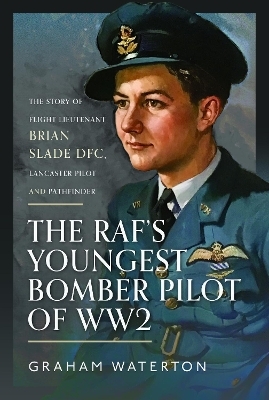
The RAF’s Youngest Bomber Pilot of WW2
The Story of Flight Lieutenant Brian Slade DFC, Lancaster Pilot and Pathfinder
Seiten
2024
Air World (Verlag)
978-1-3990-8017-0 (ISBN)
Air World (Verlag)
978-1-3990-8017-0 (ISBN)
Having left his grammar school just before his 16th birthday, Brian Slade falsified his age to pursue his dream of becoming a pilot. Within a few days of his 17th birthday, he was awarded his ‘wings’. It was the start of this teenager’s remarkable wartime career.
Soon after being awarded his pilot’s brevet, Brian was posted to his first squadron. Flying the venerable Vickers Wellington, he found himself experimenting with early target marking techniques. It was also there that Brian gained the nickname ‘The Boy Slade’.
Though Brian’s journey through the wartime RAF mirrored the experiences of tens of thousands of young men, what was different, if not unique, was the fact before he had turned 18, which was the minimum age to begin aircrew training, Brian had already completed thirty-four operations – more than was needed for a tour. This tally included the three 1,000 bomber raids against Cologne, Essen and Bremen. Unsurprisingly, he was awarded the Distinguished Flying Cross for his exploits.
Undaunted, Brian immediately volunteered for his second tour of operations. It was at this stage that he joined the Lancaster-equipped 83 Squadron in the newly formed 8 Group, becoming an experienced Pathfinder skipper. It was a role in which he marked targets in the Battle of the Ruhr, the bombing of Hamburg (Operation _Gomorrah_) and the Peenemünde raid.
_The RAF’s Youngest Bomber Pilot of WW2_, told by his nephew, a former officer in the British Army, details all of Brian’s fifty-nine missions, and captures his compelling progress with Bomber Command, alongside the technological advances in aircraft, pathfinder strategy and tactics. Sadly, Brian’s Lancaster was shot down over Berlin in August 1943/. The details of its loss remained shrouded in mystery until the puzzle of his aircraft’s demise was eventually solved by tracing the family of the only survivor.
The relent-less dangers, not just in operations but also in training, and the continuous loss of life, are drawn into sharp focus. But, on account of his age, Brian’s story is unique. There may have never been, nor will ever be, an RAF pilot of 19 years old with his flying and operational experience.
Complemented with a collection of previously unpublished photographs, _The RAF’s Youngest Bomber Pilot of WW2_ is one of the Second World War’s most amazing tales.
Soon after being awarded his pilot’s brevet, Brian was posted to his first squadron. Flying the venerable Vickers Wellington, he found himself experimenting with early target marking techniques. It was also there that Brian gained the nickname ‘The Boy Slade’.
Though Brian’s journey through the wartime RAF mirrored the experiences of tens of thousands of young men, what was different, if not unique, was the fact before he had turned 18, which was the minimum age to begin aircrew training, Brian had already completed thirty-four operations – more than was needed for a tour. This tally included the three 1,000 bomber raids against Cologne, Essen and Bremen. Unsurprisingly, he was awarded the Distinguished Flying Cross for his exploits.
Undaunted, Brian immediately volunteered for his second tour of operations. It was at this stage that he joined the Lancaster-equipped 83 Squadron in the newly formed 8 Group, becoming an experienced Pathfinder skipper. It was a role in which he marked targets in the Battle of the Ruhr, the bombing of Hamburg (Operation _Gomorrah_) and the Peenemünde raid.
_The RAF’s Youngest Bomber Pilot of WW2_, told by his nephew, a former officer in the British Army, details all of Brian’s fifty-nine missions, and captures his compelling progress with Bomber Command, alongside the technological advances in aircraft, pathfinder strategy and tactics. Sadly, Brian’s Lancaster was shot down over Berlin in August 1943/. The details of its loss remained shrouded in mystery until the puzzle of his aircraft’s demise was eventually solved by tracing the family of the only survivor.
The relent-less dangers, not just in operations but also in training, and the continuous loss of life, are drawn into sharp focus. But, on account of his age, Brian’s story is unique. There may have never been, nor will ever be, an RAF pilot of 19 years old with his flying and operational experience.
Complemented with a collection of previously unpublished photographs, _The RAF’s Youngest Bomber Pilot of WW2_ is one of the Second World War’s most amazing tales.
A former officer in the British Army, GRAHAM WATERTON felt compelled to write this story because Brian Slade was his uncle. Having learned from his mother the terrible impact of Brian’s death on her family, and the fact she knew so little about her brother, following a successful 30-year business career Graham seized the opportunity to uncover the full story of his uncle’s RAF career and his death in 1943/. As well as teaching people to fly fish, Graham writes and edit a flyfishing journal.
| Erscheinungsdatum | 22.08.2024 |
|---|---|
| Zusatzinfo | 32 mono illustrations; 32 Illustrations |
| Verlagsort | Barnsley |
| Sprache | englisch |
| Maße | 156 x 234 mm |
| Themenwelt | Literatur ► Biografien / Erfahrungsberichte |
| Sachbuch/Ratgeber ► Geschichte / Politik | |
| Geschichte ► Allgemeine Geschichte ► 1918 bis 1945 | |
| Geschichte ► Teilgebiete der Geschichte ► Militärgeschichte | |
| Sozialwissenschaften ► Politik / Verwaltung | |
| ISBN-10 | 1-3990-8017-2 / 1399080172 |
| ISBN-13 | 978-1-3990-8017-0 / 9781399080170 |
| Zustand | Neuware |
| Haben Sie eine Frage zum Produkt? |
Mehr entdecken
aus dem Bereich
aus dem Bereich
ein Psychologe erlebt das Konzentrationslager
Buch | Hardcover (2024)
Kösel (Verlag)
22,00 €
Mythos „Stauffenberg-Attentat“ – wie der 20. Juli 1944 verklärt und …
Buch | Hardcover (2024)
Goldmann (Verlag)
24,00 €


